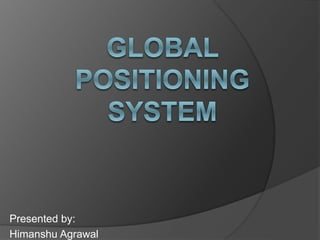
Global Positioning System
- 1. Presented by: Himanshu Agrawal
- 2. •Contents Introduction What is GPS? Components of GPS Working Principle Functioning of GPS General Applications and Devices Latest Innovations Advantages Disadvantages Conclusion Bibliography
- 3. •Introduction The current system is managed by the U.S Air Force for the Department of Defense (DOD). The current system became fully operational June 26, 1993 when the 24th satellite was lunched. A minimum of four GPS satellite signals are required to compute positions in three dimensions and the time offset in the receiver clock.
- 5. •What is GPS? Global Positioning System Space-based satellite navigation system Provides location and time information In all weather, anywhere on or near the Earth Used to refer locations and help if you are lost. Secure cars, track your vehicles By sending SMS, making a missed call, preset interval or GPS tracking software for real time online tracking
- 6. •Components of GPS 3 segments: Space segment Control segment User segment
- 8. Space segment-Information The GPS uses a constellation of 24 satellites that orbit the earth at about 11,000 nautical miles, once every 12 hours. The orbital position is constantly monitored and updated by the ground stations. Each satellite is identified by number and broadcasts a unique signal.
- 9. Space segment cont. Each satellite has 6 orbits. 3 satellites works for GPS, 4th satellite work for accuracy. 3 satellites for 2d fix. Satellite orbital distance 20,000km. Orbital speed is 14,000km/hr 60 degrees apart and 55 degrees with respect to equatorial plane. Use measurement of 4 satellites
- 11. Space segment-Satellite signals Uses two types of signals to calculate distance Code phase ranging Carrier phase ranging
- 13. •Control Segment The ground segment of GPS(US) has one master control, one alternative master control station, 12 command and control antennas and 16 monitoring sites.
- 14. •User Segment Consists of GPS receiver. The receiver collects and processes signals from the GPS satellites. Use that information to determine and display the location, speed, time and so on. The accuracy and reliability is enhanced as the number of visible satellites increases.
- 15. •Working of GPS Consist of two main components Receiver Location
- 16. Receiver The receiver collects satellite signals, decodes and processes them. The basic receiver does not include a transmitter. Different levels of precision are available. The receiver determines its location by trilateration.
- 17. GPS Trilateration Knowing its distance from three satellites, the receiver can determine its location because there is only two possible combinations and one of them is out in space. In this example, the receiver is located at b. The more satellite that are used, the greater the potential accuracy of the position location.
- 18. Location Once the GPS receiver has located its position it is usually displayed in one of two common formats: Latitude and longitude Universal transverse Mercator (UTM).
- 19. Latitude and Longitude Latitudes and longitudes are angles. Both use the center of the earth as the vertex, but they use a different zero reference.
- 20. UTM Zones The world is divided into 60 zones of latitude, each 6⁰ wide at the equator, that extend from 84⁰ N to 80⁰ s. These zones begin at 180⁰ longitude and are numbered consecutively eastward.
- 21. Dilution for Precision(DOP) The more spread out the satellites are in the sky, the better the satellite geometry. PDOP (position dilution of precision) is a combination of VDOP and HDOP. The lower the PDOP value, the better the geometric strength.
- 23. •General application Banking mobile phone operations Auto toll GPS service GPS watch Google Map Navigation
- 24. Vehicle History Tracking or “Bread Crumbing” Captures and stores a detailed GPS history of vehicle travel information. Gain visibility into field operations for greater control . Identify unproductive time in the field to increase overall productivity. No need for wireless airtime to transmit data.
- 25. Route Guidance Reduce unnecessary mileage and fuel costs by providing accurate driving directions. Improve on time performance as drivers are less likely to get “lost” or follow inefficient routes. Reduce vehicle engine idling time as driver lookup customer locations on maps.
- 26. Real Time Tracking Improved management of dispatch and fleet activities. Increased daily efficiency, productivity and accountability. Added security for vehicles.
- 27. •Devices used in GPS
- 29. Road map devices
- 30. GPS on Mobile phones
- 32. GPS equipped devices used for Engineering purposes
- 33. Use of GPS for Sports purposes
- 34. •Advantages of GPS Easy to navigate Search nearby area Weather information Tracking Updated regularly
- 35. Easy to Navigate Determine exactly where you are at any given moment. Give you the exact latitude and longitude
- 37. Weather Information Determine the atmosphere’s water content to improving the accuracy of weather forecasts
- 38. Tracking
- 39. •Disadvantages and Limitations Need good care and handling Need external power Inaccuracy Potential failures Privacy concerns Geometry of satellite position Satellite clock errors SV position
- 40. Inaccuracy Obstacles like buildings and trees can deflect the signal
- 41. Inaccuracy
- 42. •Conclusion GPS is very useful during adventures. GPS devices are perfect for water navigation. Though it has some limitation, it does not considered as a big error. Because these errors are only nano errors. GPS is the most advanced, accurate, commercially available and multi-use satellite navigation system that has ever been existed. In military application it is the only system relied upon in providing data to very expensive guided weapons.
- 43. Refrences http://www.kowama.de/en/gps http://www.aero.org/education/primers/g ps/ http://en.wikipedia.org/wiki/Global_Positi oning_System Google
- 44. References (Photos) www.geotracing.com www.pcworld.com www.realsimple.com www.bike-advisor.com www.gorge.net.au www.stratcom.mil www.ircc.iitb.ac.in www.dcrainmaker.com www.bikebiz.com www.cultofmac.com openinvo.com www.telegraph.co.uk images.businessweek.com
Hinweis der Redaktion
- Ba
